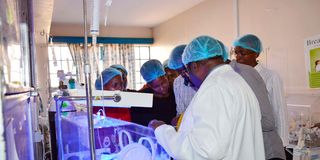No change in pre-term births as 127,000 Kenyan babies are born too early every year

Kiambu health management team checks pre-term babies at the neonatal intensive care unit at Kiambu Level Five Hospital where up to two and three infants share incubators due to influx of patients.
What you need to know:
- Although addressing the issue of small, vulnerable newborns has been on the global agenda for years, global trends show that the situation has not improved.
- This indicates a pressing need for national actors, along with global partners, to commit to providing high-quality care for all women during pregnancy and at birth.
Experts are calling for standardisation of data, technology, and quality prenatal information as national preventive measures to curb the high rate of babies born too small or too soon. The rate of such births currently stands at 20 per cent in Sub-Saharan Africa and 10 per cent in Kenya.
While announcing their findings from the latest Lancet series on small vulnerable newborns, a five-paper research series jointly done by the Children’s Investment Fund Foundation (CIFF) and Bill and Melinda Gates Foundation (BMGF) and involved experts from the Aga Khan University, Tampere University, Johns Hopkins University, London School of Hygiene and Tropical Medicine, University College London, and University of Botswana, they noted that 127,500 Kenyan babies are born too early (preterm) before completing the 37th week of pregnancy while 145,174 are born with low birth weight.
"Globally, one in every four babies in the world is either “born too small” or “born too soon”, accounting for 1.9 million stillbirths and 1.4 million newborn deaths annually. The small, vulnerable newborn survivors are vulnerable to health problems throughout their life course, affecting human capital, economic productivity, and healthcare costs.Furthermore, while the situation is the most challenging in Sub-Saharan Africa and Southern Asia, rates of data availability are also the lowest in these regions, making it difficult for decision makers to meaningfully address this issue,” they noted in their report while explaining that the series was created through an international collaboration of a group of scientists.
“It presents a new conceptual framework that brings preterm birth, small for gestational age (SGA), and low birthweight (LBW) together under the umbrella term ‘small vulnerable newborns’ (SVN). This new terminology and framework gives global and local actors a shared terminology and framing of the issue, allowing them to work together to implement change.”
According to Dr Eric Ohuma from the London School of Hygiene and Tropical Medicine, 13.4 million babies were born preterm in 2020. “ One in ten newborns were born too soon globally, with national preterm birth rates varying from under 5 per cent to above 15 per cent. There has been no change in preterm birth rates for any region in the last decade,” he said.
The experts further disclosed that 566,000 stillbirths and 5.2 million preterm or underweight births could be prevented each year by implementing eight accessible and cost-effective pregnancy interventions in low-and middle-income countries. The estimated cost of implementing these measures stands at $1.1 billion by the year 2030.
The series provides low-cost, evidence-based pregnancy interventions for the prevention of small vulnerable newborns and stillbirths. These interventions include multiple micronutrient supplements, treatment of syphilis, and treatment of asymptomatic bacteriuria (a bacterial infection of the urine) for all women. The targeted interventions provided include low-dose aspirin, balanced protein energy supplements, prevention of malaria in pregnancy, progesterone provided vaginally, and smoking cessation.In addition, implementing girls’ and women’s reproductive rights is key to preventing pregnancy complications and poor pregnancy outcomes.Speaking during the launch of the Lancet series in Kenya, the acting head of the informatics division of the Ministry of Health, Dr Job Nyangena, reiterated the government’s commitment to implementing these preventive measures.
“As a government, and especially with the devolution of health services, we are developing technological specifications to ensure standardisation of operating procedures and training manuals,” he said.
Although addressing the issue of small vulnerable newborns has been on the global agenda for years, global trends show that the situation has not improved. This indicates a pressing need for national actors, along with global partners, to commit to providing high quality of care for all women during pregnancy and at birth. This includes implementing the World Health Organisation's antenatal care guidelines that include a screening ultrasound for all pregnant women.
According to Prof Marleen Temmerman, the director of Aga Khan University’s Centre of Excellence in Women and Child Health, East Africa, action on the matter is a moral responsibility.
“One out of four babies is born too early, too small, or stillborn. It is our moral duty to invest in prevention of small vulnerable newborns through early and high quality antenatal and childbirth care and through girls and women reproductive rights,” said Prof Temmerman.
The experts called for African governments and relevant actors to urgently prioritise action, advocate for, and invest in the prevention of small vulnerable newborns to reverse the current trend, reduce small vulnerable newborns outcomes, and ultimately save the lives of millions of babies.
“Twenty per cent of babies born in Sub-Saharan Africa are small vulnerable newborns, yet prevention is possible. This is the challenge we all need to tackle, the Nairobi launch aims to help us do this,” says Dr Abdu Mohiddin, a physician and assistant professor at the Aga Khan University.





